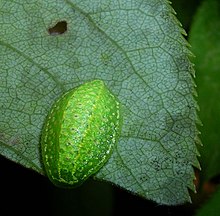Snail moth
| Snail moth | ||||||||||
|---|---|---|---|---|---|---|---|---|---|---|

Great snail moth ( Apoda limacodes ) |
||||||||||
| Systematics | ||||||||||
|
||||||||||
| Scientific name | ||||||||||
| Limacodidae | ||||||||||
| Duponchel , 1845 |
The limacodidae , Assel Spinner or sign moths (Limacodidae) are a family of butterflies (Lepidoptera). They occur worldwide with around 1,000 species . Their main distribution area are the tropics .
features
The moths reach a wingspan of 16 to 32 millimeters. They have medium to robustly built bodies, the shape of which is very stocky and stocky. Their forewings are short and wide and are only 1.6 to 2.1 times longer than wide. At rest, they are laid out like a roof on the body and are usually monochrome brown, greenish or shiny metallic. Their hind wings are similar in shape to the fore wings, but strongly rounded. The antennae are short and only reach about half the length of the forewings. In the case of the males, there are both types with thread-shaped, as well as types with combed antennae. The maxillary palps are well developed, or are reduced or absent, depending on the species. The proboscis are absent in all species .
The forewings have 13 wing veins with two anal veins (1b and 1c). The hind wings have 10 veins with three anal veins (1a, 1b, and 1c).
Way of life
The moths are nocturnal. Since they cannot eat any food, they only have a very short life expectancy of about a week. During this time they live only to procreate.
The caterpillars , which are active at dusk and at night, have a crawling sole instead of a pair of belly legs, similar to snails . This allows them to move around, but also to suck on leaves. The sternum pairs are poorly developed. Young caterpillars sometimes have cone-like elevations on the body, older stages of development are slightly hairy. Their coloration varies from bright yellow to red and green to blue. Some species have stinging hairs , which can also cause skin irritation in humans. The animals are found sitting on their forage plants. Pupation takes place in a cocoon either on the leaves of the plants or on the ground between leaves.
Systematics
In the whole of Europe only five species are known, of which two species occur in Central Europe .
- Great snail moth ( Apoda limacodes ) ( Hufnagel , 1766), A, CH, D
- Small snail moth ( Heterogenea asella ) ( Denis & Schiffermüller , 1775), A, CH, D
- Hoyosia codeti ( Oberthür , 1883)
- Hoyosia cretica ( Rebel , 1906)
- Parasa sinica Moore 1877
supporting documents
Individual evidence
- ↑ Limacodidae in Fauna Europaea. Retrieved June 23, 2011
- ↑ Limacodidae. Lepiforum eV, accessed on June 23, 2011 .
literature
- Günter Ebert (Ed.): The Butterflies of Baden-Württemberg Volume 3, Moth I (Root Borers (Hepialidae), Wood Borers (Cossidae), Ram (Zygaenidae), Snail Moth (Limacodidae), Sack Bearer (Psychidae), Window Spot (Thyrididae)), Ulmer Verlag Stuttgart 1993. ISBN 3-8001-3472-1
Web links
- Fam. Limacodidae woodpecker, moth moth ( Memento from July 4th, 2008 in the Internet Archive )
- British Insects: the Families of Lepidoptera
